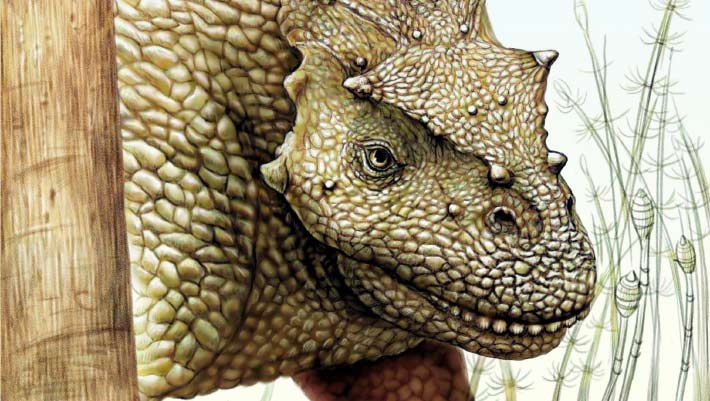Paleontologists have identified a new genus and species of mid-sized pareiasaur from two fossilized specimes found in China in 2018.
An artist’s reconstruction of Yinshanosaurus angustus. Image credit: X.-C. Guo, Institute of Vertebrate Paleontology and Paleoanthropology.
Named Yinshanosaurus angustus, the newly-identified species roamed Earth during the latest Permian period, between 259 and 254 million years ago.
The ancient beast was a member of Pareiasauria, a specialized group of herbivorous tetrapods that existed throughout the supercontinent Pangea during the Middle-Late Permian.
“Pareiasauria are a bizarre herbivorous clade of tetrapods that existed in the Guadalupian and Lopingian and were victims of both the Late Capitanian and the end-Permian mass extinction events,” said Dr. Jian Yi and Jun Liu from the Institute of Vertebrate Paleontology and Paleoanthropology at the Chinese Academy of Sciences, the University of Chinese Academy of Sciences, and Chongqing Institute of Paleontology.
“Pareiasauria has a worldwide distribution, with fossils discovered in Africa, Europe, Asia and South America.”
“Pareiasaurs were common primary consumers in several terrestrial tetrapod faunas, including the Late Permian fauna of northern China.”
“Since the 1960s, eight Chinese pareiasaur species have been described.”
Two specimens — a nearly complete skull and an articulated partial postcranial skeleton with a nearly complete skull — were unearthed in China in 2018.
“The first specimen was excavated form the dark purple siltstone in the lower part of the Sunjiagou Formation, near Zhangjiagetuo village, Baode county, Xinzhou city, Shanxi,” the paleontologists said.
“The second specimen was excavated from purplish silty mudstone in the upper part of Member I of the Naobaogou Formation, near Qiandian village, Shiguai district of Baotou City, Nei Mongol.”
According to the authors, Yinshanosaurus angustus had the narrowest skull of all pareiasaurs, with skull length more than twice the skull width at the lateral edges of the cheeks.
“The skeleton of Yinshanosaurus angustus provides the complete cranial and articulated postcranial details of Chinese pareiasaurs for the first time,” they said.
Their paper was published this month in the journal Papers in Palaeontology.
_____
Jian Yi & Jun Liu. 2025. The tetrapod fauna of the upper Permian Naobaogou Formation of China: a new mid-sized pareiasaur Yinshanosaurus angustus and its implications for the phylogenetic relationships of pareiasaurs. Papers in Palaeontology 11 (3): e70020; doi: 10.1002/spp2.70020
